I know it sounds cheesy, but pizza really is my favorite food. It has endless possibilities and usually includes my favorite things: bread, tomatoes, and cheese. And when you make your pizza crust from scratch, pizza is one of the cheapest dinners you can make. The best part? All of the ingredients for homemade pizza dough are pantry staples, so you can make this whenever without planning ahead. AND it’s freezer-friendly so you can always have some stashed and ready to thaw on a moment’s notice.

This post contains some affiliate links, which means that we make a small commission off items you purchase at no additional cost to you.
What is in Homemade Pizza Dough?
While there are several styles of pizza dough out there in the world, this particular recipe is super simple and only includes:
- Water
- Yeast
- Sugar
- Salt
- Flour
- Olive Oil
That’s it! Really! This particular recipe creates a crust that is crispy on the outside, but still tender on the inside. If you use a rolling pin to really compact the dough and roll it thin, you’ll get a result that more closely resembles a crispy thin-crust pizza. Toss the dough by hand, gently stretching the dough and leaving some thickness will give you that crispy-yet-tender finish, with a few of those awesome big bubbles.
What Kind of Yeast Can I Use?
The instructions below will work with active dry or instant yeast. If you’re looking for a pizza crust without yeast, check out my No-Yeast Pizza Dough Recipe.
How to Freeze Pizza Dough
After kneading the pizza dough, form it into a ball, coat the dough ball with a little oil to keep it from sticking to the plastic, then wrap tightly in plastic wrap. Place the plastic wrapped dough ball in a heavy duty freezer zip top bag, label, date, and place it in the freezer!
How to Thaw Pizza Dough
To thaw your frozen pizza dough, place it in the refrigerator the night before you intend to bake the pizza. The dough will rise slightly as it thaws. The other option is to allow the dough to thaw at room temperature, which will take about two hours. You’ll want to unwrap the pizza dough from the plastic before letting it thaw. Place the frozen dough in an oiled bowl and cover loosely with a clean towel as it thaws.
Try These Homemade Pizza Flavors:
- BBQ Chicken Pizza
- Breakfast Pizza
- Garlicky Kale and Ricotta Pizza
- Ultimate Portobello Mushroom Pizza
- White Pizza with Parsley Pesto Drizzle
- Spicy Hawaiian Pizza
- Hummus and Grilled Vegetable Pizza
- Stromboli
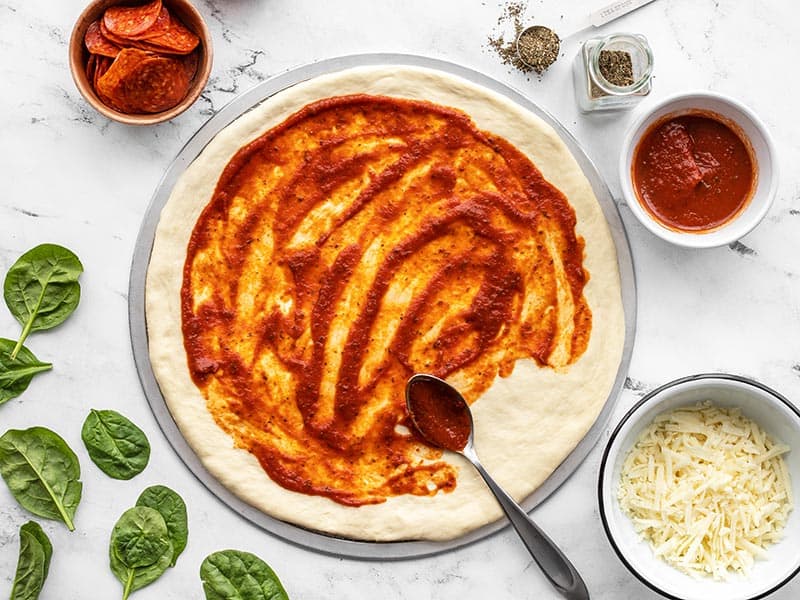
Make some homemade pizza sauce to go with your pizza crust!
Homemade Pizza Dough

Ingredients
- 3/4 cups warm water ($0.00)
- 1 tsp yeast* ($0.08)
- 1 Tbsp sugar ($0.05)
- 2 cups all-purpose flour ($0.30)
- 1 tsp salt ($0.03)
- 1 Tbsp olive oil ($0.16)
Instructions
- Dissolve the yeast and sugar in the warm water. Allow the yeast water to sit for about 5 minutes, or until a thick layer of foam develops on top.
- While you’re waiting for the yeast, add 1 cup of the flour and the salt to a large bowl, then stir well to combine.
- Add the olive oil to the yeast water, then pour the mixture into the bowl with the flour and salt. Begin adding more flour to the bowl, ¼ to ½ cup at a time, until it forms a ball of dough that can no longer be stirred with a spoon.
- Turn the dough out onto a lightly floured work surface, then knead for about 5 minutes, adding a little flour as you go to keep it from sticking.
- At this point you have three options: use the dough tonight (one hour after kneading), use it tomorrow (allowing it to rise in the refrigerator over night) or within a month (freezing the dough).
To Use the Pizza Dough Same Day
- Place the kneaded dough back into the mixing bowl, drizzle with a little oil, then turn the dough to coat it with oil. Cover the bowl loosely and let the dough rise in a warm place for one hour, or until it is double in volume.
- Once risen, stretch or roll the dough out to a 14 to 16-inch circle, place on a pizza pan, and top with your favorite sauce and toppings. Bake the pizza in a preheated 450ºF oven for 10-12 minutes or until the edges are brown and crispy.
To Use the Pizza Dough the Next Day
- Allowing the dough to proof (rise) slowly in the refrigerator for 18-24 hours gives the dough even more flavor. Form the dough into a ball and coat with oil. Place the dough in a covered container and refrigerate for 18-24 hours. Allow the dough to come to room temperature before stretching, topping, and baking.
To Freeze the Dough for Future Use
- Form the kneaded dough into a ball, coat it with oil, wrap tightly in plastic wrap, then place in a freezer bag and transfer to the freezer. When you are ready to use the dough, simply place it on the counter for one hour prior to use. The dough should be at room temperature before stretching, topping, and baking.
See how we calculate recipe costs here.
Notes
Nutrition
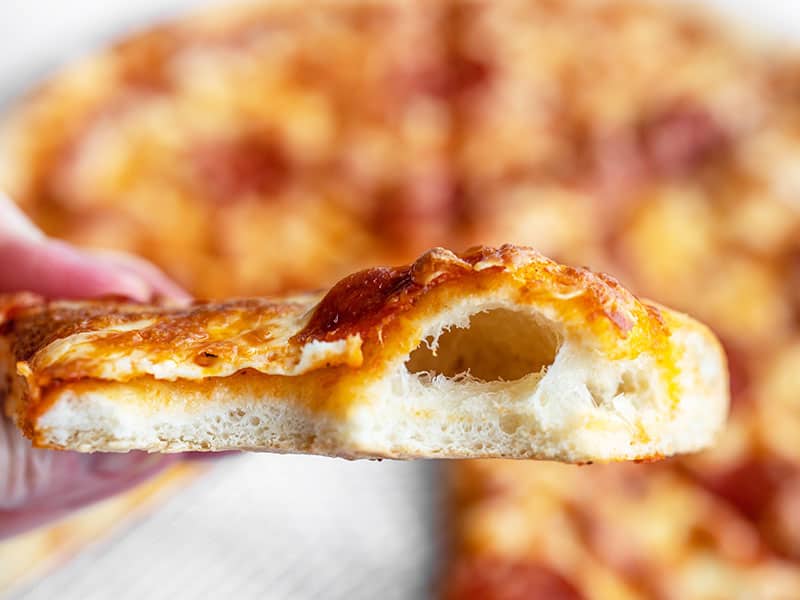
How to Make Homemade Pizza Dough – Step By Step Photos
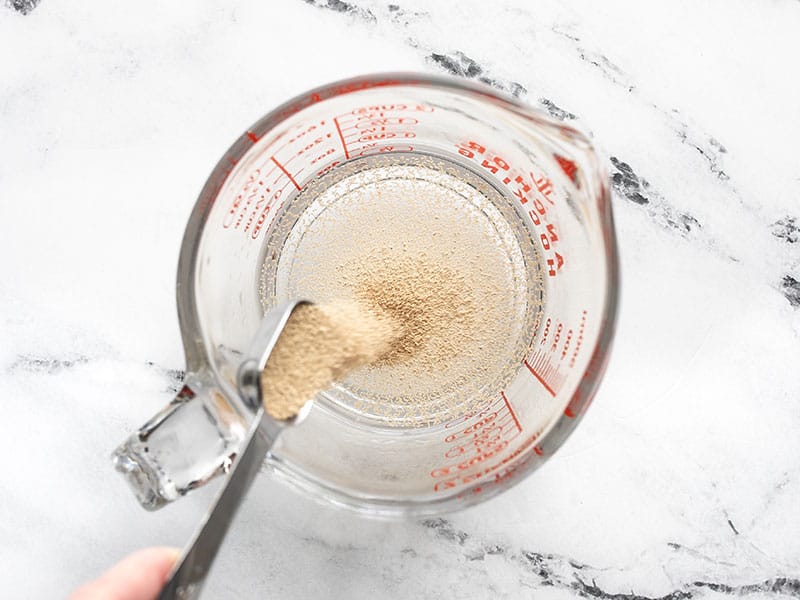
Start this classic pizza crust recipe by dissolving 1 tsp active dry yeast (or instant yeast) and 1 Tbsp sugar in ¾ cup warm water.
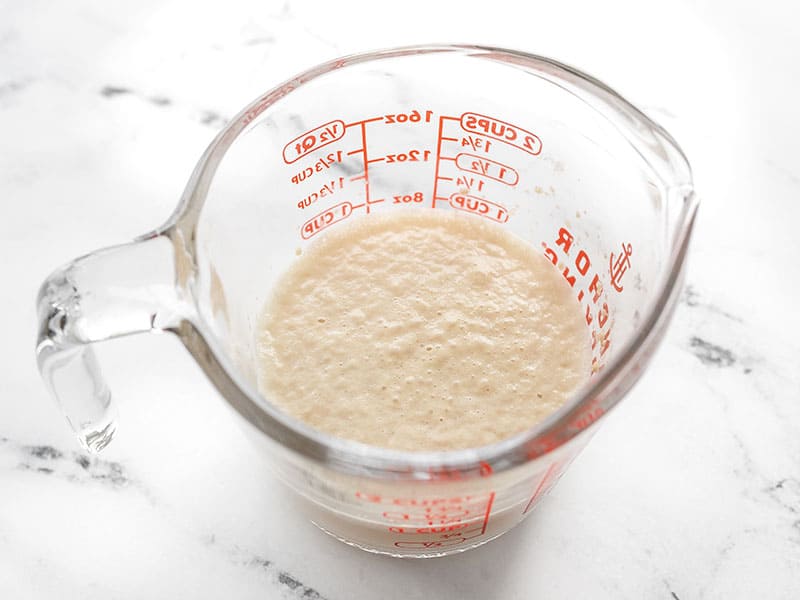
Let the yeast water sit for about 5 minutes, or until a thick layer of foam develops on top.
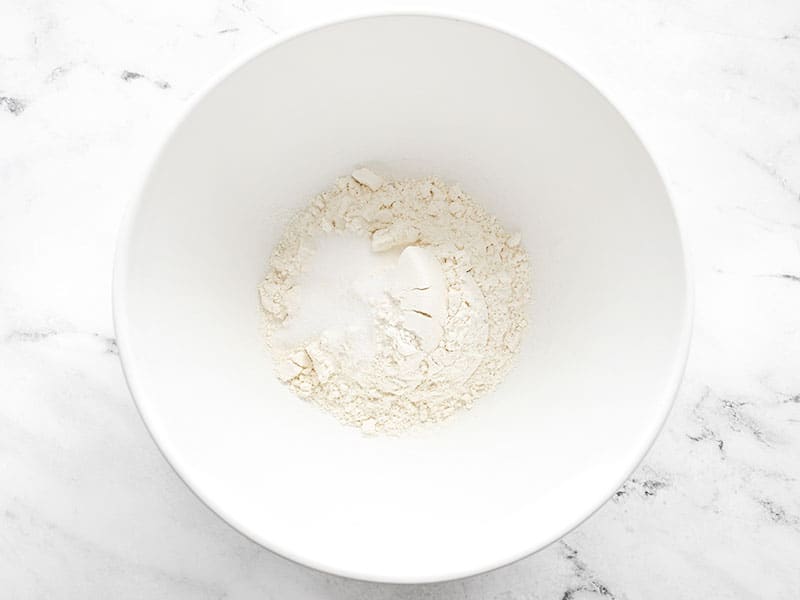
While the yeast is blooming, combine 1 cup all-purpose flour and 1 tsp salt in a mixing bowl. Stir until combined.
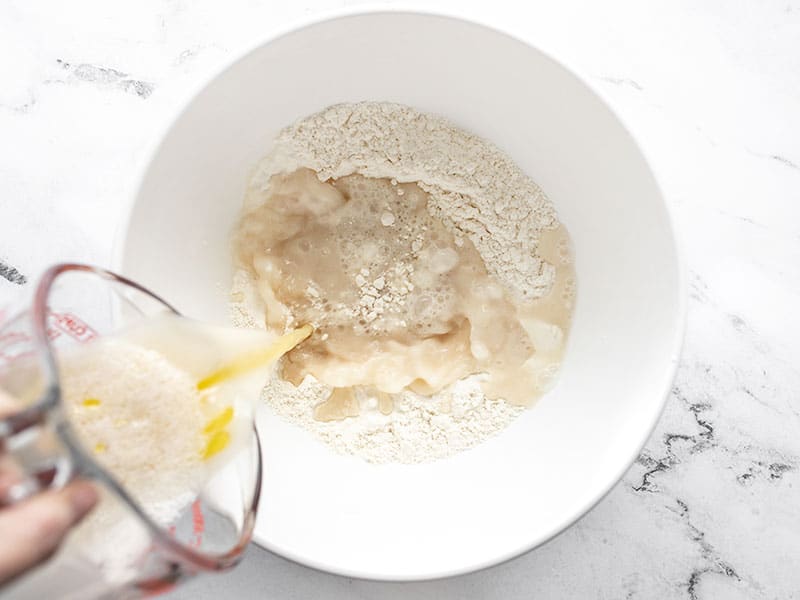
Add 1 Tbsp olive oil to the yeast water, then pour it into the bowl with the flour and salt. Stir until the mixture is fairly smooth.
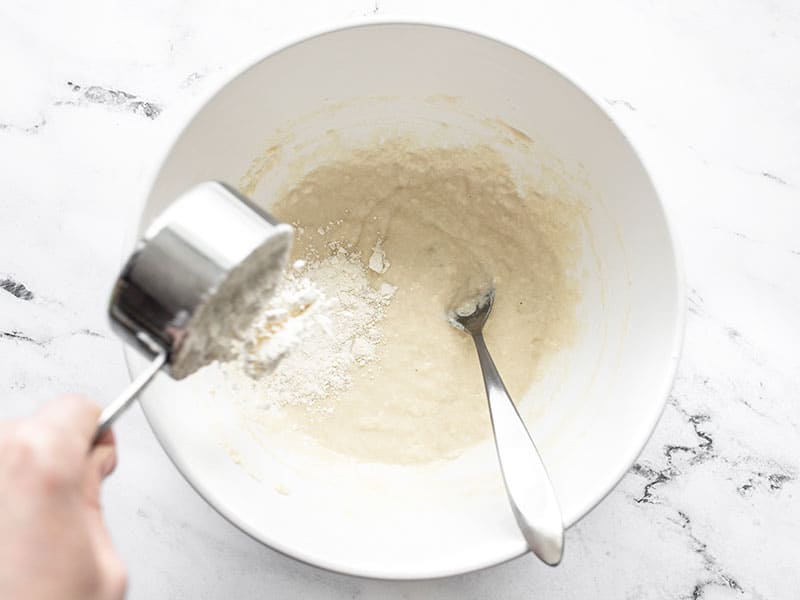
Begin adding more flour, about ¼ to ½ cup at a time, until you can no longer stir the mixture with a spoon.
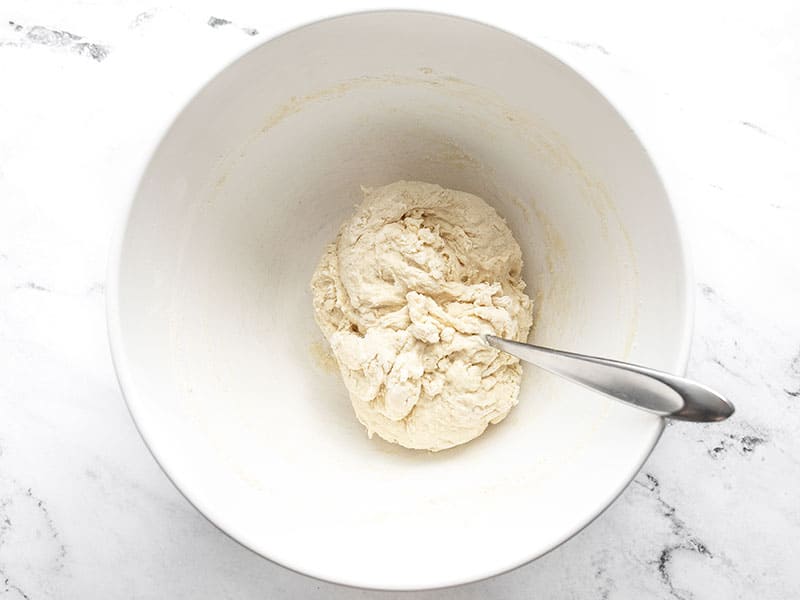
Once it forms a ball that you can no longer stir with a spoon, turn it out onto a clean, lightly floured work surface.
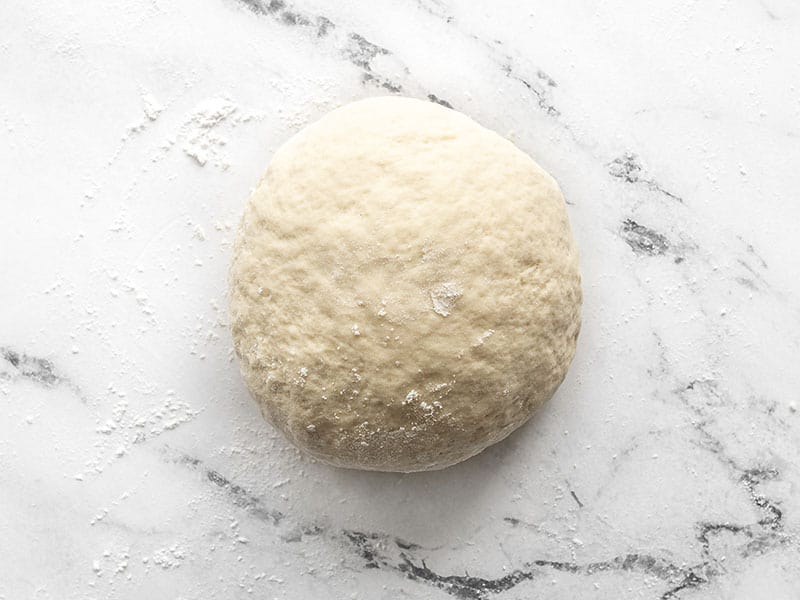
Knead the dough for about 5 minutes, adding a little flour as you go to prevent it from sticking. Once kneaded, you should have used about 2 cups flour total, since the first step of stirring salt into the flour. Total flour amount can vary depending on humidity and other factors. At this point you can let the dough rise and make a pizza same day, refrigerate the dough and make pizza with it the next day, or freeze the dough for future use.
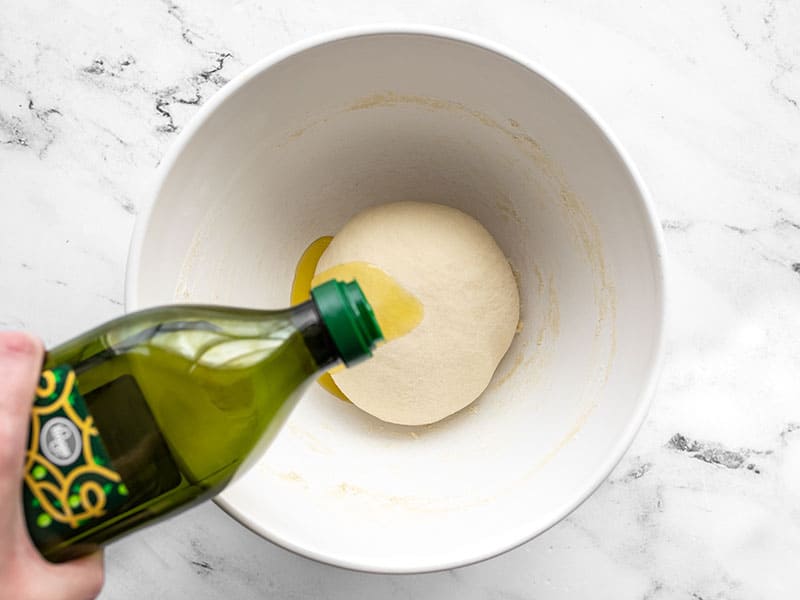
To make a pizza same day: Place the dough ball back into the mixing bowl, add just a small drizzle of oil, and turn the dough to coat it in the oil. The oil will keep the dough from drying out as it rises.
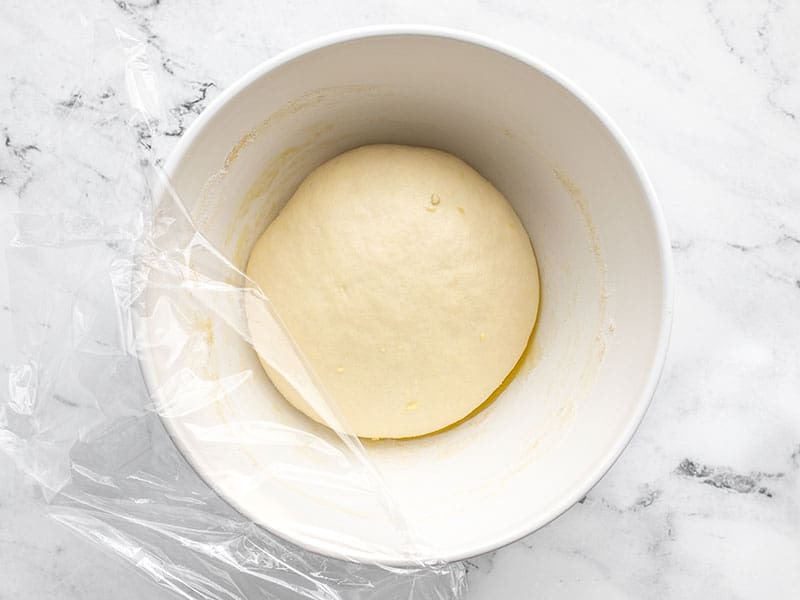
Loosely cover the bowl with plastic wrap and let the dough rise for about an hour, or until it is double in size.
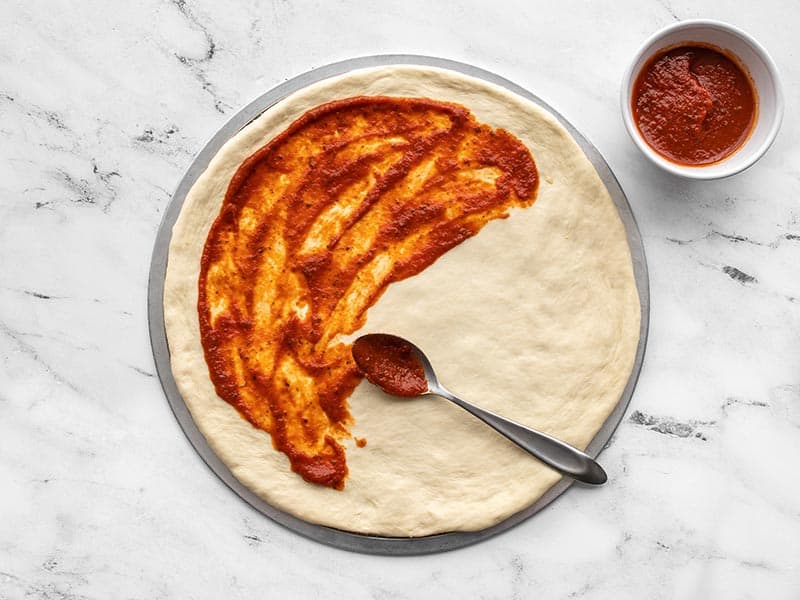
Preheat the oven to 450ºF. Stretch or roll the pizza dough out to 14-16 inches and place on a pizza pan. Add your favorite pizza sauce…
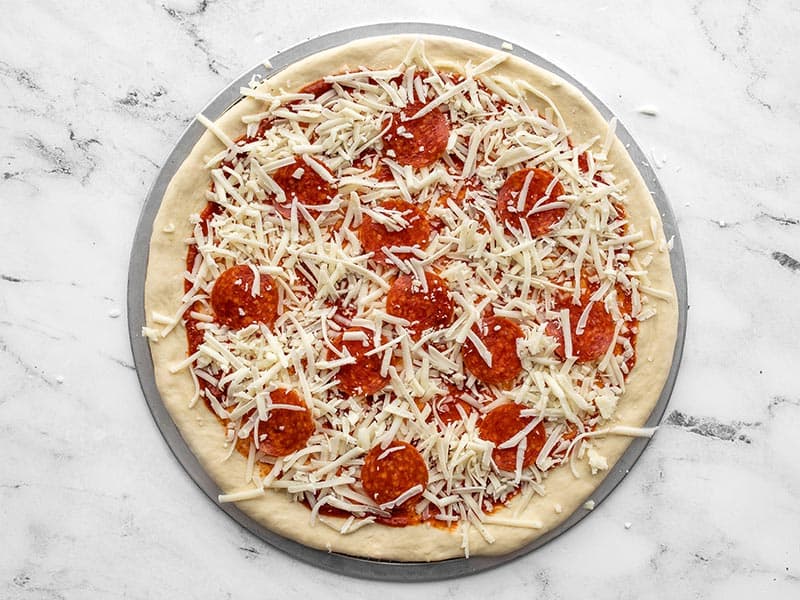
And your favorite pizza toppings…

Bake in the fully preheated oven for 10-12 minutes, or until the crust and toppings are browned.

Slice and enjoy!


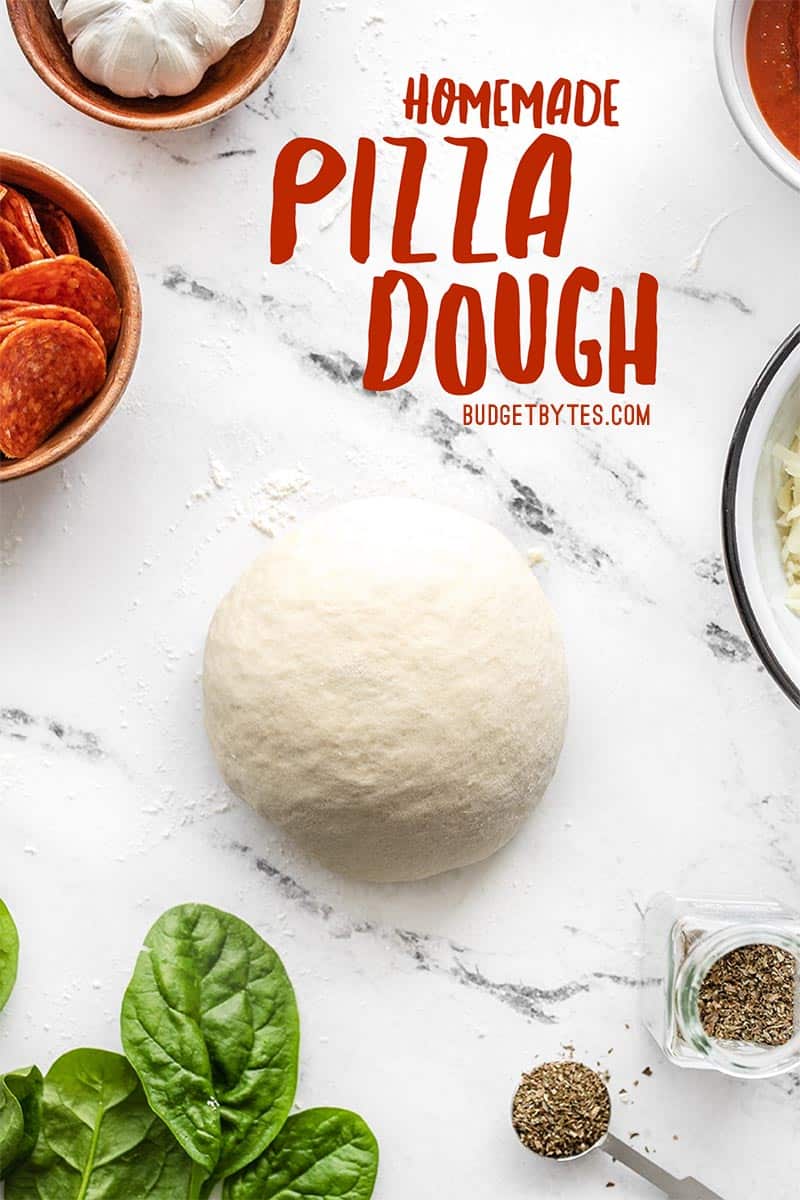

Love this recipe to make pizza at home that’s FAR superior to frozen and fun, easy, and very cheap to make. Last time, I doubled the recipe to freeze half. Freezing the dough was fine, but I highly recommend you defrost in the fridge the day before, and not on the countertop at room temperature. It took FOREVER to defrost and I was hungry. I ended up defrosting the dough by placing it in a ziploc bag in warm water, which wasn’t ideal but still made for a good pizza. Next time I will triple the recipe and freeze enough for two pizzas, since the pizza sauce recipe makes enough for three also. It won’t be as easy to knead as just one pizza worth of dough but it’s not too much either.
The single most important thing I found was to Not use Treated water from any utility company. It contains anti bacterial chemicals. The water here will kill the action of the Yeast. Hand filtered or pure bottled water raises my yeast every time.
I made this dough last night. A double batch seemed like the perfect amount to stretch out in a sheet pan. I cooked it at 450 for ~15 minutes and it looked done. But I found that the dough was rather soft and bready.
Any idea what I should have done differently? Was it because I used a sheet pan? Or perhaps I let the yeast get a little too frothy (5 minutes wasn’t enough and I had a nice layer of bubbles after more like 10 minutes)?
Doing a long ferment for the dough (like leaving it in the refrigerator for a day, maybe two) can help develop the gluten more so it will be less soft and fluffy. But yes, cooking it on a sheet pan instead of something super hot like a pizza stone will also keep it soft instead of getting a nice crispy bottom.
I tried this again last night with much better results. Got the pizza stone ripping hot (preheated the oven for a half hour), prepared the pizza on parchment paper, and put it directly on the stone for ~14 minutes. Using parchment was far far easier than trying to slide a pizza off a pizza peel!
This recipe is going in the rotation along with many others I have discovered on this site. Thank you!
This is okay pizza dough, but I think the servings are misleading. This does not serve 4. It serves one. Don’t make the same mistake I did. Plus, the water and flour ratios seem off, which makes me think metric would serve better for dough since the way that people scoop flour will change how much flour ends up being used (whether someone sifts, spoons, or just scoops with the cup).
Serves one?? I was able to feed my family of 5 with this recipe.
I don’t know why I use any cooking sites but budgetbytes. After a few trial and errors I finally tried the simplest recipe posted here and it was BY FAR the best. Instant yeast worked well as a replacement.
FYI, it was absolutely perfect dough for calzones.
Hi
Would you be able to send this recipe in grams please?
Thanks
Kamal
This is a great recipe! I’ve made it a bunch of times and had a few batches early on that came out extremely sticky even when using the same amount of flour. I’ve pinned down the variable for me: the yeast foam. At first I would give it just the 5 minutes then mix it in, even if it hadn’t really foamed. However if I wait until a good foam develops, the dough ends up way more workable. This is important because when it’s sticky it’s pretty much impossible to knead, and is then difficult to stretch. So let the yeast foam!! I used yeast with a 2022 expiration date today and it still took a good 15 mins or so. I’m sure the quality matters and probably characteristics of your water too. Beth does say to make sure it’s foamed and that’s what you should go by, just be aware that it might take a good bit more than 5 mins.
This recipe isn’t gluten free.
I don’t have it listed as gluten-free. Where are you seeing that? I’d like to correct it if it says gluten-free somewhere.
Love the recipe! One thing I tweak is adding a touch of garlic powder and basil/Italian seasoning to the flour mixture. Turned out so well though!
Do you let the dough rise then freez
Nope, you’ll want to freeze it before it has risen. :)
I’m interested in making a garlic and herb dough, would I be able to add the ingredients to this recipe?
I haven’t tried it to know for sure, but I would think that you would be able to add some dried herbs and garlic powder to the flour mixture to give it those flavors.
I think I commented when you first posted this, but in the months since, this recipe has been a quarantine lifesaver. We prefer thin crust pizza. As my best pan makes a 12″ pizza, this is plenty for 2. I bake one the day I make the dough and freeze the other half.
I won’t buy any more frozen pizza and not at all sure we will ever go out for pizza again, since this is easy, authentic, and delicious–and inexpensive, particularly since I discovered that Aldi’s yeast is half the price as my regular supermarket. I’ve also had fun subbing half the white flour with whole wheat–some minor time and quantity adjustments since the absorption properties and gluten content are slightly different for whole wheat. It’s particularly yummy with pizzas that don’t use red sauce.
I keep yeast in the fridge–it lasts at least a year after the expiration date, although 2 year old yeast might take more than 5 minutes to get started. Fortunately I had a good supply last March because it was very hard to find in my local stores at least until late June.
How long should the dough knead for in a stand mixer
I haven’t used a stand mixer to knead this dough, unfortunately.
I used a stand mixer this time after kneading in the past. I stirred everything together in the mixer bowl by hand until it got too thick, then switched to the dough hook on speed 2 for 5 minutes (ocassionally scraping off the hook). I just sprayed oil around the sides of the same bowl to get the dough covered for the rise, so I only had to use one bowl. It worked fine!
Actually, I think I used speed 3 for kneading. Speed 2 was a little slow to move the dough around.
I use the stand mixer each time and always double the recipe. Once all the flour is in, speed 2-4 until it is coming off the sides of the bowl and doesn’t stick to your fingers. So easy and little mess. Then I cut that big ball in 1/2, use the same mixer bowl to let the night’s dough rise and freeze the other ball.
We love thin crust so we make this on a stainless steel pizza stone in the oven at 450 and it comes out perfectly crispy with big bubbles!
The last few times I’ve made pizza dough, it’s so sticky I can’t even roll it out without most of the dough getting on my hands and the pizza stone. I end up tossing it in the trash.
My guess — and it’s just a guess– is that I have the water temperature wrong. When you say warm water, what temp should it be? I was thinking of using a thermometer next time to get it exact. Thanks!
If the dough is too sticky it is an issue with the water to flour ratio, not the water temperature. I would try kneading in a bit more flour. :) I just use warm tap water, like bath water, and don’t ever use a thermometer for this.
Thank you so much!
How do I time making dough for dinner ?
Can I let it sit out for a few hours if dinner is late ?
Thanks again
Begin the dough so that you’ll have one hour of rise time before you top and bake your pizza. If it’s going to be longer than that, place the dough in the refrigerator to keep it from over rising, but allow it to rise for one hour at room temperature.